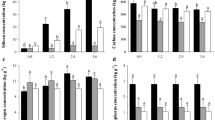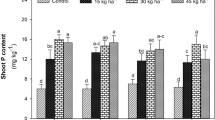Abstract
SULPHUR dioxide (SO2) in the air at high concentrations may be injurious to higher plants: at low concentrations it is not injurious. On the basis of experimental exposures1, a concentration of about 429 µg SO2 m−3 (0.15 p.p.m.) has been widely accepted as a threshold below which a range of higher plants would not be injured even during prolonged exposure. The dividing line between injurious and non-injurious concentrations is not well defined because plants vary in their susceptibility to injury according to the species, stage of growth, environmental factors, such as light intensity, humidity, water supply, and the duration of the exposure at a given concentration2. The injurious effects of SO2 have been investigated extensively but much less attention has been given to its effects at non-injurious concentrations. This aspect deserves further study because in some circumstances the effects of SO2 are known to be beneficial. Thus, it has been observed that (i) the rate of photosynthesis in lucerne, as measured by the uptake of carbon dioxide, was increased by exposing the plants to air containing 486 µg SO2 m−3 for 66 h (ref. 3) and (ii) the yields of dry matter of several species growing in solution culture were enhanced when the shoots were exposed for 9 to 20 days in air containing SO2, labelled with 35S, at 200 and 500 µg m−3; 35S appeared in both organic and inorganic fractions of the plant sulphur4. The fact that SO2 can be utilized after absorption through the shoots may be of widespread significance in crop nutrition in industrialized countries. Indeed, we have found recently5 that when ryegrass was grown on sixteen soils from England and Wales in a controlled environment cabinet with air filtered to remove SO2, the plants developed sulphur deficiency on all soils except one; deficiency has not been encountered in crops growing on these soils in the field. The inputs of sulphur from the air and rainfall to plants and soils under field conditions are not known with certainty, but in rural areas in Britain the air near the ground contains on average 50 µg SO2 m−3 (ref. 6) and for urban areas the average is slightly above 100 µg m−3 (ref. 7).
This is a preview of subscription content, access via your institution
Access options
Subscribe to this journal
Receive 51 print issues and online access
$199.00 per year
only $3.90 per issue
Buy this article
- Purchase on Springer Link
- Instant access to full article PDF
Prices may be subject to local taxes which are calculated during checkout
Similar content being viewed by others
References
Zahn, R., Staub, 21, 56 (1961).
Thomas, M. D., in Air Pollution, 233 (Monograph Series 46, WHO, Geneva, 1961).
Katz, M., Ind. Eng. Chem., 41, 2450 (1949).
Faller, N., Herwig, K., and Kuhn, H., Pl. Soil, 33, 283 (1970).
Jones, L. H. P., Cowling, D. W., and Lockyer, D. R., Soil Sci., 114, 104 (1972).
Warren Spring Laboratory, The Acidity of Rain, and the Sulphur Dioxide in the Air in Country Districts in the UK and Ireland (HMSO, London, 1970).
Craxford, S. R., Weatherley, M.-L. P. M., and Gooriah, B. D., in Proc. Thirty-eighth Clean Air Conference, 114 (National Society for Clean Air, Brighton, 1971).
Cowling, D. W., and Jones, L. H. P., Soil Sci., 110, 346 (1970).
Adams, D. F., Corn, M., Harding, C. L., Pate, J. B., Plumley, A. L., Scaringelli, F. P., and Urone, P. F., Health Laboratory Science, 7 (Supplement), 4 (1970).
Ulrich, A., and Hylton, L. O., Pl. Soil, 29, 274 (1968).
Bell, J. N. B., and Clough, W. S., Nature, 241, 47 (1973).
Unsworth, M. H., Biscoe, P. V., and Pinckney, H. R., Nature, 239, 458 (1972).
Author information
Authors and Affiliations
Rights and permissions
About this article
Cite this article
COWLING, D., JONES, L. & LOCKYER, D. Increased Yield through Correction of Sulphur Deficiency in Ryegrass exposed to Sulphur Dioxide. Nature 243, 479–480 (1973). https://doi.org/10.1038/243479a0
Received:
Published:
Issue Date:
DOI: https://doi.org/10.1038/243479a0
This article is cited by
-
Grassland species are more efficient in acquisition of S from the atmosphere when pedospheric S availability decreases
Plant and Soil (2019)
-
Importance of sulphur in crop production
Biogeochemistry (1984)
-
SO2 pollution reduces the freezing resistance of ryegrass
Nature (1982)
-
Sulphur and nitrogen nutrition and misting effects on the response of bluegrass to ozone, sulphur dioxide, nitrogen dioxide or their mixture
Water, Air, and Soil Pollution (1981)
Comments
By submitting a comment you agree to abide by our Terms and Community Guidelines. If you find something abusive or that does not comply with our terms or guidelines please flag it as inappropriate.



